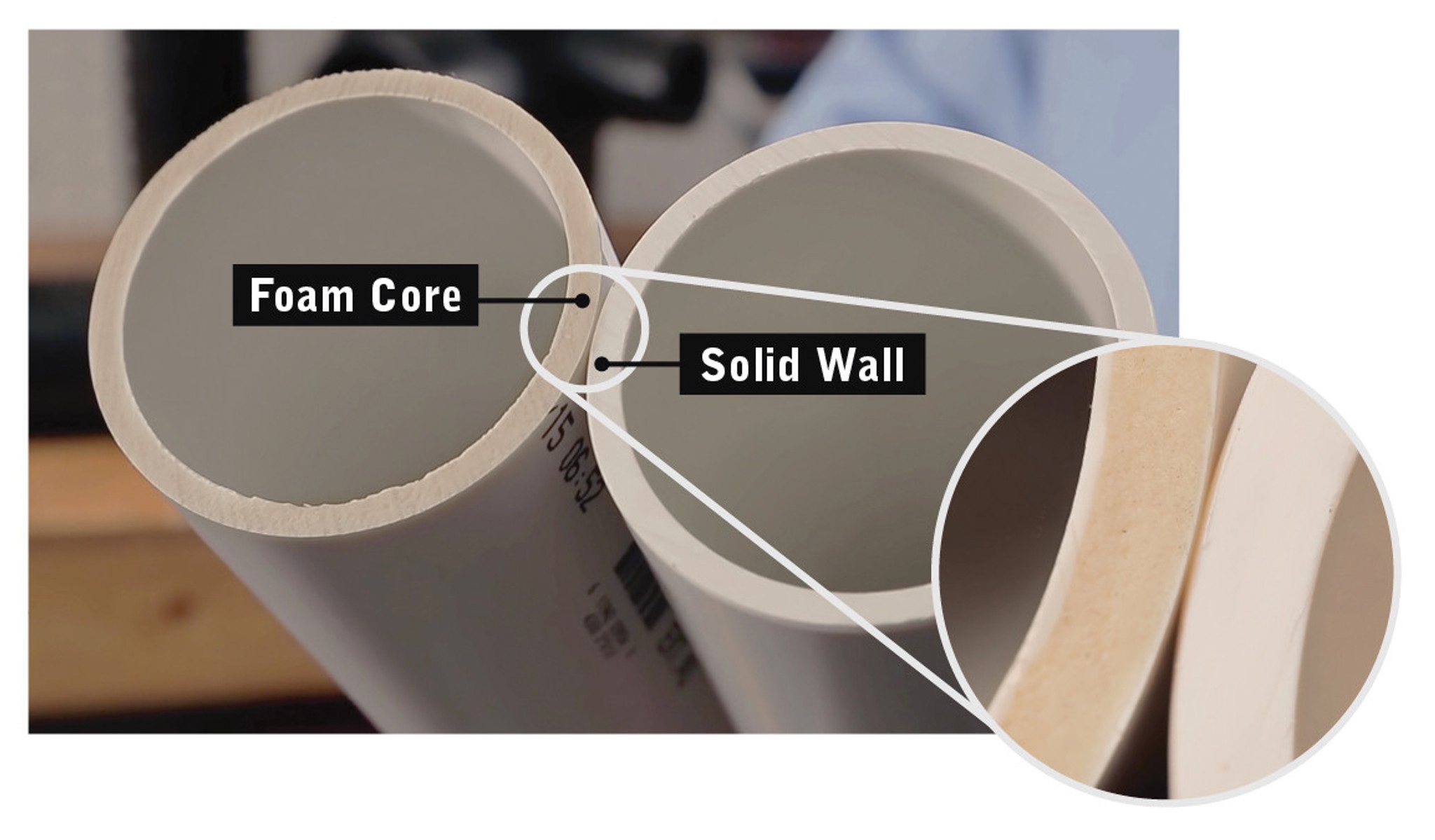Article
Why Foam Core PVC Is Not Right For Your Commercial Project
Plumbing technology has evolved dramatically over the decades. During the past 60 years, commercial drain, waste, and vent systems have been value-engineered from traditional hub-and-spigot cast iron soil pipe systems to those constructed with cellular core PVC, commonly known as “foam core pipe.”
How did we get here, and is this latest proposed alternative the right choice for commercial plumbing?
A Brief History of Value Engineering in Commercial DWV
While traditional hub-and-spigot cast iron soil pipe was the go-to specification for commercial projects in the United States through the 1960s, the introduction of hubless CISP provided labor and material cost savings to plumbing contractors in the decades that followed. Additionally, an even lower-cost system — PVC — began appearing in multistory buildings in the U.S. around the 1960s–1970s, mostly in single-family homes and occasionally in multifamily applications. However, it was not until the Great Recession of 2007 that contractors began offering PVC as a low-cost alternative in commercial building projects in earnest.
Today, the debate over whether to opt for CISP or PVC on commercial projects continues. Meanwhile, foam core PVC, an even lower-cost alternative, is becoming more popular.
Developed in France in 1979 by Alphacan, a large, multinational pipe company, foam core PVC gained traction due to its economical production and reduced weight. By the late 1980s, this technology was widely available in the U.S.
However, as plumbing contractors and engineers assess their options for commercial projects, it’s imperative to take a discerning look at the options.
Let’s explore the complexities of foam core PVC, including the potential drawbacks of value engineering in commercial projects.
What is foam core PVC?
Foam core PVC is positioned as a cost-effective, lightweight alternative to the denser pipe materials of tradition. Manufactured to ASTM F891, this product features a foamed PVC core encased by thin, solid PVC layers. The use of a blowing agent during extrusion displaces the amount of PVC resin in the center layer, differentiating it from solid wall PVC.

“In essence, foam core PVC has less PVC than solid wall PVC pipe,” said Paul Tully, a field technical representative at Charlotte Pipe and Foundry. “As a result, foam core PVC is listed for gravity systems only and is not rated for pressure.”
This type of pipe is identified by the print line on the pipe, which generally includes terms such as “COEX,” “CELLULAR CORE,” and “NOT FOR PRESSURE.”
Code-Compliance Concerns
Foam core PVC produced to ASTM F891 is an approved material in the model plumbing codes. However, one must be cautious, as some local jurisdictions enforce specific restrictions on foam core PVC application in commercial construction.
While code adherence is crucial, plumbing engineers and designers must recognize that it’s merely a starting point. A thorough evaluation of material suitability for a given project is paramount.
It is also important to note that many plumbing professionals commonly refer to solid wall PVC as “schedule 40,” while both solid wall and foam core PVC are manufactured to schedule 40 dimensions. Schedule 40 has to do with only the dimensions of the pipe and not with the materials of its composition.
If engineers scan the piping submittals and see “Sch 40,” they may think they are getting solid wall PVC pipe. However, submittals for solid wall PVC pipe will contain references to ASTM D2665 and ASTM D1785, not ASTM F891.
Comparing Foam Core PVC With Solid Wall PVC Pipe: 6 Things to Consider
Let’s explore six key factors that should be evaluated when choosing between these two types of PVC pipe.
1. Strength and Reliability
As flexible systems, both foam core and solid wall PVC piping systems work with the surrounding soil to support an earth or live load, termed the “soil-pipe mechanism,” which is calculated by the Iowa formula.
The Uni-Bell PVC Pipe Association publishes a helpful calculator based on the Iowa formula that allows a designer to input variables specific to the application. The variables include maximum allowable deflection, soil modulus, load parameters, additional live loads, pipe diameter, and pipe stiffness.
The pipe stiffness values differ for foam core PVC and solid wall PVC pipe for most diameters. They indicate that solid wall PVC demonstrates superior load capacity.
2. Sound Attenuation
Foam core PVC’s lower density often translates to it being perceived as a “noisy” DWV pipe.
Acoustic performance is influenced by material density, favoring denser materials for sound attenuation. Despite arguments for sound-attenuation products, the labor costs for their addition may negate the cost benefits of foam core PVC. For settings where noise control is crucial, such as schools and hospitals, foam core PVC might not be the best choice.
3. Temperature Constraints
Foam core and solid wall PVC pipe share identical temperature capabilities, topping out at a maximum operating temperature of 140 degrees Fahrenheit.
4. Installation Complexities
Both options employ a two-step solvent welding process for joining, and there is also no distinction between the two different piping systems in regard to cutting, preparation, joining, cure times, and set times.
However, a significant contrast emerges in subterranean installations. Foam core PVC necessitates meticulous care due to size restrictions, unlike its counterpart.
5. Maintenance Implications
Facilities requiring regular cleaning of their drain lines should tread carefully when it comes to foam core PVC. Repeated passes with a mechanical cleaning device can eventually nick, chip, or wear down the thin inner wall to the point where the foam core is exposed. While there’s no definitive equation to determine pipe degradation from mechanical use, privy professionals often opt for solid wall PVC to circumvent potential issues.
6. Jobsite Vulnerabilities
In a similar vein, foam core pipe’s dual-skin design renders it more vulnerable to damage on the jobsite. Surface impairments can lead to increased leaks or even “weeping” under sustained static head pressure due to blockages.
To determine whether foam core PVC is acceptable or appropriate for a given commercial project, evaluate these decision criteria:
- Does the authority having jurisdiction allow foam core piping in commercial construction?
- What are the burial conditions?
- What are the backfill materials?
- Is sound attenuation important for the successful use of the facility?
- Will the lower price of using foam core PVC outweigh the cost of adding higher-performing sound-abatement materials?
- Will the facility require regular or frequent cleaning using mechanical devices?
- Will the savings generated by using foam core PVC outweigh any potential future issues?
“While foam core PVC touts advantages — such as cost savings, lighter weight, and easy cutting — these merits must be weighed against potential compromises in strength, sound attenuation, installation, and maintenance obligations,” Tully noted.
As the plumbing industry evolves, foam core PVC continues to emerge as a contender for commercial projects: Its cost-effectiveness, lightweight nature, and ease of handling are alluring traits. Nevertheless, the prudent plumbing professional recognizes that every material selection must balance the product’s unique strengths and shortcomings.
In the quest for the optimal plumbing solution, it’s essential to exercise critical thinking, thoroughly evaluating both sides of the equation. As foam core PVC becomes ever more enticing, plumbing contractors and engineers must deliberate the potential pitfalls, highlighting the necessity of making informed decisions that transcend immediate cost considerations.



